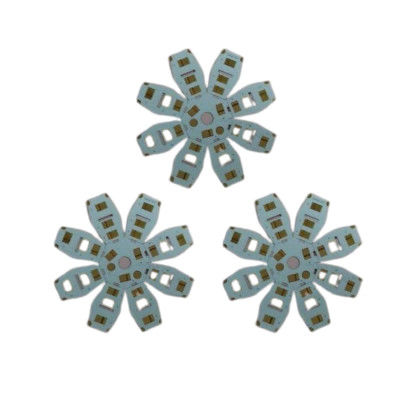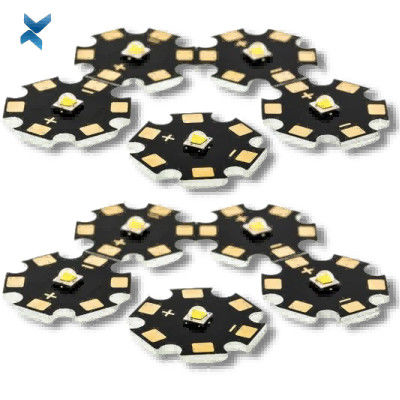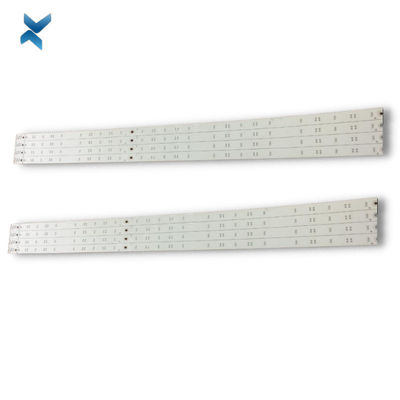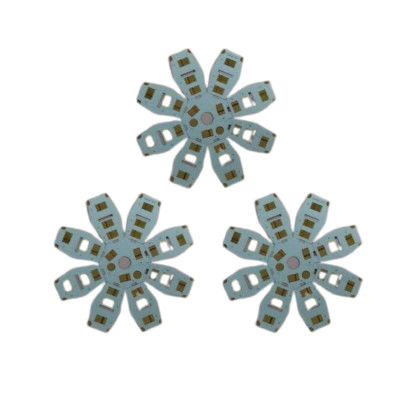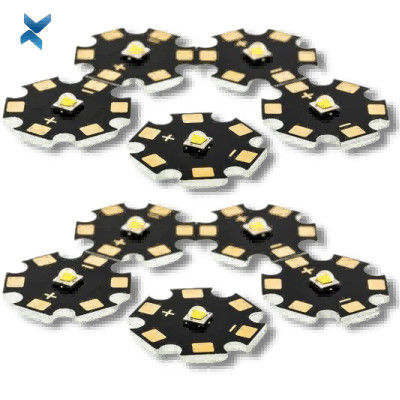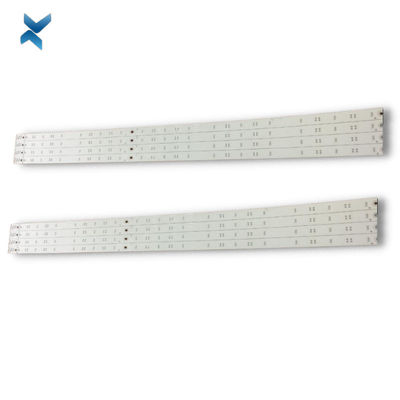1.6mm Thick LED Aluminum Plate PCB Board For Blossom Lights
| Place of Origin | Shenzhen |
|---|---|
| Brand Name | YScircuit |
| Certification | ISO9001,UL,REACH, RoHS |
| Model Number | YS-LE-0009 |
| Minimum Order Quantity | 1 piece |
| Price | 0.03-6$/piece |
| Packaging Details | Foam cotton + carton + strap |
| Delivery Time | 2-8 days |
| Payment Terms | T/T,PayPal, Alibaba pay |
| Supply Ability | 251,000 square meter/year |

Contact me for free samples and coupons.
Whatsapp:0086 18588475571
Wechat: 0086 18588475571
Skype: sales10@aixton.com
If you have any concern, we provide 24-hour online help.
x| Material | Aluminum | Size | According To Customer Request |
|---|---|---|---|
| Process | Immersion Gold | Surface Finishing | HASL/HASL-LF/ENIG/OSP |
| Min. Line Spacing | 2.5cm | Board Thickness | 1.6mm |
| Application | Blossom Lights | Name | Blossom Lights PCB |
| High Light | 1.6mm LED Aluminum Plate PCB Board,Blossom LED Aluminum Plate PCB Board |
||
Aluminum Pcb Customization Led Print Circuit Board For Blossom Lights
Using LED PCBs in electronics has quite a lot of benefits, likes below:
Light Weight and Small Size
LED PCBs are lightweight and come in a small size, which means you can use them in projects where a small-sized, lightweight LED PCB is required. They won’t add to the weight of the overall electronic circuitry.
Low Power Consumption
Compared to other sources of light, such as bulbs, LEDs have low power consumption.
They don’t dissipate as much heat as traditional bulbs do.
According to a study, LEDs use 75% less energy than traditional bulbs, which means that using LED PCBs will help you save electricity.
Long-Lasting
Using LED PCBs instead of the traditional bulbs will save you from replacing them time, and because LEDs have a much longer lifespan, they will last you for a long time.
High Efficiency
LEDs do not dissipate a large amount of heat, which means they are highly efficient as compared to other sources of light energy.
Using an LED PCB for incorporating lighting in your project will save you from wasting electrical energy by converting it into heat energy.
Using an LED PCB will improve the efficiency of your project.
Easy to Integrate
LED PCBs are easy to integrate, which means that you can incorporate them into complex projects and electronic circuits without any hassle.
They do not need a large amount of circuitry or expertise to be connected to a circuit system.
All you need to do is connect the positive and negative terminals present on the LED circuit board to a power supply.
Dust and Moisture Free
Dust and moisture are the two major enemies of electronic circuits.
High quality LED PCBs are dust and moisture resistant, which means you don’t have to worry about dust particles and moisture droplets ruining your LED circuit board.
Mercury-Free
Using LEDs instead of other types of lighting will save you from the guilt of introducing toxic substances, such as mercury, into the environment.
LED circuit boards are mercury-free, which is a great benefit that they offer.
No Radiofrequency Emission
Another great advantage of using LED PCBs is that they do not emit RF waves during operation.
If RF waves are sent out a device, they will interfere with other electronic devices and components present in the surroundings.
Using an LED PCB will save you from worrying about RF interference.
Environmental Friendly
Overall, LED PCBs are considered to be environmentally friendly since they do not emit harmful substances, and they last for a long time, which means you dispose of them once in a while, hence creating less waste.
Wide Range Availability
LED PCBs are available in a wide range of colors and sizes.
You can choose from a variety of LED colors and can also customize the circuit board dimensions according to your application.
Reduces Operational Costs
Using LED PCBs instead of other sources of lighting has proved to reduce operational costs because they are more efficient and last for a long time, which means that they help you save money in the long run.
| Layer | 1-24 |
| Material | Aluminum core (Domestic 1060), Copper core, FR4 covering |
| Thickness (Finished Board) | 0.8 mm-5.0 mm |
| Max. Board Size | 610 mm*610 mm |
| Copper weight (finished) | 0.5 oz-4.0 oz |
| Surface Finish | Hot air solder leveling (HASL) Lead-free HASL: RoHS compliant Electroless nickel/immersion gold (ENIG): RoHS compliant |
| Min. Tracing/Spacing | 4 mil/4 mil |
| Min. diameter of drill | 8mil |
| Min. Annular ring | 4mil |
| Soldermask Color | Green, red, black, yellow, white, blue, green matt, black matt |
| Silkscreen Legend Color | White, Black, Yellow |
| Countersink holes | Yes |
| Screw holes | Yes |
| layer/m² | S<1㎡ | S<3㎡ | S<6㎡ | S<10㎡ | S<13㎡ | S<16㎡ | S<20㎡ | S<30㎡ | S<40㎡ | S<50㎡ | S<65㎡ | S<85㎡ | S<100㎡ |
| 1L | 4wds | 6wds | 7wds | 7wds | 9wds | 9wds | 10wds | 10wds | 10wds | 12wds | 14wds | 15wds | 16wds |
| 2L | 4wds | 6wds | 9wds | 9wds | 11wds | 12wds | 13wds | 13wds | 15wds | 15wds | 15wds | 15wds | 18wds |
| 4L | 6wds | 8wds | 12wds | 12wds | 14wds | 14wds | 14wds | 14wds | 15wds | 20wds | 25wds | 25wds | 28wds |
| 6L | 7wds | 9wds | 13wds | 13wds | 17wds | 18wds | 20wds | 22wds | 24wds | 25wds | 26wds | 28wds | 30wds |
| 8L | 9wds | 12wds | 15wds | 18wds | 20wds | 20wds | 22wds | 24wds | 26wds | 27wds | 28wds | 30wds | 30wds |
| 10L | 10wds | 13wds | 17wds | 18wds | 20wds | 20wds | 22wds | 24wds | 26wds | 27wds | 28wds | 30wds | 30wds |
| 12L | 10wds | 15wds | 17wds | 18wds | 20wds | 20wds | 22wds | 24wds | 26wds | 27wds | 28wds | 30wds | 30wds |
| 14L | 10wds | 16wds | 17wds | 18wds | 20wds | 20wds | 22wds | 24wds | 26wds | 27wds | 28wds | 30wds | 30wds |
| 16L | 10wds | 16wds | 17wds | 18wds | 20wds | 20wds | 22wds | 24wds | 26wds | 27wds | 28wds | 30wds | 30wds |
![]()
![]()
![]()
![]()
![]()
WHAT IS AN ALUMINUM PCB?
A PCB generally consists of three layers. A conductive copper layer at the top, a dielectric layer in between, and a layer of a substrate at the bottom. Standard PCBs have a substrate layer made of fiberglass, ceramic, polymers, or any other non-metal core. An ample amount of PCBs uses FR-4 as the substrate.
Aluminum PCBs use an Aluminum substrate. Instead of standard FR-4 as the substrate material.
Circuit Copper Layer
This layer transmits signals over the entire PCB board.
The movement of charged particles generates heat.
This heat is transferred to the Aluminum substrate. Which dissipates it efficiently.
Insulating Layer
This layer is also known as the dielectric layer.
It is made of materials that are poor conductors of electricity.
It absorbs the heat generated in the above layer. And transfer it to the Aluminum substrate below it.
Substrate
The substrate acts as a foundation for the PCB.
It firmly holds the components above it. By changing the characteristics of the substrate, the performance of PCB varies.
For example, a rigid substrate provides strength and durability to the PCB board.
While a flexible substrate opens up more design options.
The aluminum substrate is used in power electronics-based applications where high thermal dissipation is required.
Due to its good thermal conductivity, it keeps heat away from vital electronic components. Thus ensuring minimal circuit damage.
ALUMINUM PCBs MANUFACTURED AT YScircuit
YScircuit is one of the finest manufacturers of Aluminum PCBs.
To increase the overall performance of the product, they provide a thermal clad layer to the Aluminum PCB.
It dissipates heat in a highly efficient manner. For high power and tight tolerance based applications Aluminum Backed PCB is the perfect choice among project makers.
Considering parameters like the coefficient of thermal expansion, thermal conductivity, strength, hardness, weight, and cost. Aluminum plate is an ideal choice for your project. You can modify your PCB substrate. PCBWay offers different Aluminum plates like 6061, 5052, 1060, and many more.
ADVANTAGES OF ALUMINUM PCB
1. The heat dissipation capacity of Aluminum PCBs is far better than standard PCBs.
2. Aluminum PCBs provide more strength and durability. As compared to ceramic and fiberglass-based PCBs.
3. It seems ironic, but aluminum-based PCBs are lighter. As compared to standard PCBs.
4. Thermal expansion and contraction of PCB components get reduce by using Aluminum PCB.
5. PCBs made of Aluminum are environmentally friendly. It is non-toxic and recyclable. It does not create any harmful impacts on our planet.
6. The assembling process of Aluminum PCB is easy than that of standard PCB.
APPLICATIONS
1. They are used in Power supply devices like switching regulators, DC/AC converter, SW regulator.
2. In power modules, they are used in inverters, solid-state relays, and rectifier bridges.
3. In automobiles, they are used in an electronic regulator, ignition, power supply controller, etc.
4. They are the perfect choice for amplifiers. Balanced amplifier, audio amplifier, power amplifier, operational amplifier, high-frequency amplifier.
5. They are used in the transmitting and filtering circuit.
6. They are used to make the CPU board. And power supply of computers.
7. Electric motors require a high current for their operation. In industries, motor driver circuits use Aluminum PCB.
8. These are a popular choice for LED applications due to their energy-saving capability.




